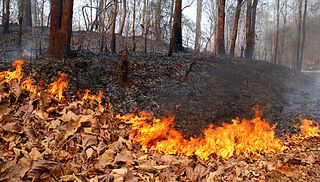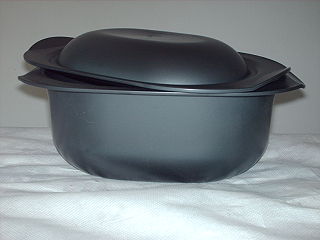Related Research Articles

The Gulf of Thailand, also known as the Gulf of Siam, is a shallow inlet in the southwestern South China Sea, bounded between the southwestern shores of the Indochinese Peninsula and the northern half of the Malay Peninsula. It is around 800 km (500 mi) in length and up to 560 km (350 mi) in width, and has a surface area of 320,000 km2 (120,000 sq mi). The gulf is surrounded on the north, west and southwest by the coastlines of Thailand, on the northeast by Cambodia and the Mekong Delta region of Vietnam, and opens to the South China Sea in the southeast.

Bang Bo is a district (amphoe) of Samut Prakan province in Thailand.

Agriculture in Thailand is highly competitive, diversified and specialized and its exports are very successful internationally. Rice is the country's most important crop, with some 60 percent of Thailand's 13 million farmers growing it on fully half of Thailand's cultivated land. Thailand is a major exporter in the world rice market. Rice exports in 2014 amounted to 1.3 percent of GDP. Agricultural production as a whole accounts for an estimated 9-10.5 percent of Thai GDP. Forty percent of the population work in agriculture-related jobs. The farmland they work was valued at US$2,945 per rai in 2013. Most Thai farmers own fewer than eight hectares of land.

Khlong Saen Saep is a canal (khlong) in central Thailand, connecting the Chao Phraya River to Prachinburi Province and Chachoengsao. A portion of the canal is used for public transport by an express boat service in Bangkok. The 72 km long canal passes through 21 districts and is connected to more than 100 smaller canals.

Thailand's dramatic economic growth has caused numerous environmental issues. The country faces problems with air, declining wildlife populations, deforestation, soil erosion, water scarcity, and waste issues. According to a 2004 indicator, the cost of air and water pollution for the country scales up to approximately 1.6–2.6% of GDP per year. As such, Thailand's economic growth has come at great cost in damage to its people and environment.

Waste sorting is the process by which waste is separated into different elements. Waste sorting can occur manually at the household and collected through curbside collection schemes, or automatically separated in materials recovery facilities or mechanical biological treatment systems. Hand sorting was the first method used in the history of waste sorting.

The waste management in Switzerland is based on the polluter pays principle. Bin bags are taxed with pay-per-bag fees in three quarters of the communes. The recycling rate doubled in 20 years due to this strategy. The recycling rate for municipal solid waste exceeds 50 percent.

Banpu Public Company Limited is an energy company based in Thailand. Its three core businesses are energy resources ; energy generation ; and energy technology. As of 2015 Banpu is headed by CEO Somruedee Chaimongkol. In the 2012 Forbes Global 2000, Banpu was ranked as the 1707th -largest public company in the world.
Ko Lan is one of the eastern seaboard islands of Thailand. Ko Lan lies 7.5 km from the nearest shore, Pattaya. "Ko Lan" is the name of the island in the Royal Thai General System of Transcription. It is also known as "Koh Larn" and "Ko Laan".

The Ministry of Natural Resources and Environment is a cabinet ministry in the Government of Thailand.

Rice production in Thailand represents a significant portion of the Thai economy and labor force. In 2017, the value of all Thai rice traded was 174.5 billion baht, about 12.9% of all farm production. Of the 40% of Thais who work in agriculture, 16 million of them are rice farmers by one estimate.

The Department of National Park, Wildlife and Plant Conservation (DNP), Thai: กรมอุทยานแห่งชาติ สัตว์ป่า และพันธุ์พืช) is an agency of the Ministry of Natural Resources and Environment. Its headquarters are in Chatuchak District, Bangkok. Since February 2016 the director-general of the DNP has been Thanya Netithammakun. In FY2018 DNP's budget is 11,574 million baht.

Plastic pollution is the accumulation of plastic objects and particles in the Earth's environment that adversely affects humans, wildlife and their habitat. Plastics that act as pollutants are categorized by size into micro-, meso-, or macro debris. Plastics are inexpensive and durable, making them very adaptable for different uses; as a result, manufacturers choose to use plastic over other materials. However, the chemical structure of most plastics renders them resistant to many natural processes of degradation and as a result they are slow to degrade. Together, these two factors allow large volumes of plastic to enter the environment as mismanaged waste and for it to persist in the ecosystem.

Plastic containers are containers made exclusively or partially of plastic. Plastic containers are ubiquitous either as single-use or reuseable/durable plastic cups, plastic bottles, plastic bags, foam food containers, Tupperware, plastic tubes, clamshells, cosmetic containers, up to intermediate bulk containers and various types of containers made of corrugated plastic. The entire packaging industry heavily depends on plastic containers or containers with some plastic content, besides paperboard and other materials. Food storage nowadays relies mainly on plastic food storage containers.

Packaging waste, the part of the waste that consists of packaging and packaging material, is a major part of the total global waste, and the major part of the packaging waste consists of single-use plastic food packaging, a hallmark of throwaway culture. Notable examples for which the need for regulation was recognized early, are "containers of liquids for human consumption", i.e. plastic bottles and the like. In Europe, the Germans top the list of packaging waste producers with more than 220 kilos of packaging per capita.
China's waste import ban, instated at the end of 2017, prevented foreign inflows of waste products. Starting in early 2018, the government of China, under Operation National Sword, banned the import of several types of waste, including plastics. The ban has greatly affected recycling industries worldwide, as China had been the world's largest importer of waste plastics and processed hard-to-recycle plastics for other countries, especially in the West.

Data from the Solid Waste Management and Public Cleansing Corporation (SWCorp) collected from January to November throughout 2018 puts the national recycling rate at 0.06%, or about 1,800 tonnes of the 3 million tonnes of waste collected in the period. Majority of the waste were sent to landfills.

Waste management in South Korea involves waste generation reduction and ensuring maximum recycling of the waste. This includes the appropriate treatment, transport, and disposal of the collected waste. South Korea's Waste Management Law was established in 1986, replacing the Environmental Protection Law (1963) and the Filth and Cleaning Law (1973). This new law aimed to reduce general waste under the waste hierarchy in South Korea. This Waste Management Law imposed a volume-based waste fee system, effective for waste produced by both household and industrial activities.

South Korean waste disposal policy operates under the Ministry of Environment. Waste is required to be separated into four parts: landfill waste, organic waste, recyclable waste, and large waste items. Recyclable waste such as: paper, plastics and glass, should be separated before disposal. Fines are applicable to violations of the policy.
In Egypt, waste and lack of proper management of it pose serious health and environmental problems for the country and its population. There has been some governmental attempts to better the system of waste management since the 1960s but those have not proven sufficient until now. In the last 10 years focus on this issue and solutions to it has increased both from the government and civil society. Some attempts at recycling are present, and growing in the country. But these are largely informal or private actors, and government initiatives are necessary to properly manage these systems and provide them with appropriate resources.
References
- 1 2 3 "How Thailand is hurtling towards a massive waste disposal crisis". First Post. 2014-09-01. Retrieved 9 September 2016.
- ↑ Suksamran, Nauvarat (11 December 2017). "Suttipong told to clean up or else". Bangkok Post. Retrieved 11 December 2017.
- 1 2 Mala, Dumrongkiat (13 June 2016). "Media 'must help solve waste issue'". Bangkok Post. Retrieved 13 June 2016.
- 1 2 Gheewala, Shabbir (2011-12-10). "Thai Style Recycling". Waste Management World (WMW). Retrieved 13 June 2016.
- ↑ Yukako, Ono; Iwamoto, Kentaro (6 October 2016). "Waste is in the spotlight as governments think green". Nikkei Asian Review. Retrieved 6 October 2016.
- ↑ Jiaranaikhajorn, Taweechai. "Waste and Hazardous Substances Management Bureau" (PDF). Pollution Control Department (PCD). Retrieved 22 November 2014.
- ↑ "Pollution Control Department (PCD) Statement". Ministry of Natural Resources and Environment.
- ↑ Visvanathan, C. "Hazardous and Industrial Solid Waste Management in Thailand—an Overview" (PDF). www.faculty.ait.ac.th/visu/. Asian Institute of Technology Thailand. Retrieved 22 November 2014.
- ↑ "Genco Background". General Environment Conservation Public Company Ltd. Retrieved 22 November 2014.
- ↑ "About SGS". SGS (Thailand) Ltd. Retrieved 22 November 2014.
- ↑ "About Waste Management Siam, Ltd. (WMS)". Waste Management Siam Ltd. Retrieved 22 November 2014.
- ↑ "About BWG". Better World Green Public Company Ltd. Retrieved 22 November 2014.
- ↑ "About Us". Wongpanit. Retrieved 9 September 2016.
- ↑ Chaiyong, Suwitcha (29 January 2020). "A large portion of the blame". Bangkok Post. Retrieved 29 January 2020.
- 1 2 "Time to get tough with plastic users" (Editorial). Bangkok Post. 2017-07-23. Retrieved 23 July 2017.
- 1 2 Wipatayotin, Apinya (5 September 2017). "Ministry plans road map for marine waste control". Bangkok Post. Retrieved 5 September 2017.
- ↑ "Thailand makes an effort to protect marine environment from marine debris and land-based pollution". The Ocean Conference. United Nations. Retrieved 5 September 2017.
- ↑ Wipatayotin, Apinya (14 February 2018). "PCD to axe water bottle seals by end of year". Bangkok Post. Retrieved 15 February 2018.
- ↑ Wipataotin, Apinya (22 July 2018). "Bid to cut plastic use irks shoppers, traders". Bangkok Post. Retrieved 22 July 2018.
- ↑ Atthakor, Ploenpote (23 July 2018). "Bag campaign 'not consistent with reality'". Bangkok Post. Retrieved 23 July 2018.
- ↑ Charoensuthipan, Penchan (6 February 2020). "Ailing plastic businesses seek rescue". Bangkok Post. Retrieved 7 February 2020.
- ↑ "Thailand kicks off 2020 with plastic bag ban". Channel News Asia. 1 January 2020. Retrieved 10 January 2020.
- ↑ Techakitteranun, Hathai (10 January 2020). "Thailand's plastic bag ban puts 1,000 factories in dire straits". The Straits Times. Retrieved 10 January 2020.
- ↑ Wipatayotin, Apinya; Arunmas, Phusadee (10 January 2020). "New panel set up to tackle waste disposal". Bangkok Post. Retrieved 10 January 2020.
- ↑ Wattanasukchai, Sirinya (10 January 2020). "Plastic bag ban fails to send the right message" (Opinion). Bangkok Post. Retrieved 10 January 2020.
- ↑ Hicks, William (21 January 2020). "Activists decry plastic ban loopholes". Bangkok Post. Retrieved 25 January 2020.
- ↑ Apisitniran, Lamonphet (23 September 2016). "Waste management capacity on the rise". Bangkok Post. Retrieved 23 September 2016.
- ↑ Srimalee, Somluck (21 July 2018). "Making a hole in medical waste". The Nation. Retrieved 21 July 2018.
- ↑ Beech, Hannah; Jirenuwat, Ryn (8 December 2019). "Recycled laptops triggering toxic fumes in Thailand". New York Times. Retrieved 11 December 2019– via The Independent.
- ↑ Webster, Douglas; Theeratham, Patharaporn (2004-11-17). "Policy Coordination, Planning and Infrastructure Provision: A Case Study of Thailand" (PDF). World Bank. Retrieved 23 September 2016.
- ↑ Wancharoen, Supoj (15 November 2016). "BMA mulls billing for waste water". Bangkok Post. Retrieved 15 November 2016.
- 1 2 3 4 5 Thailand State of Pollution Report 2015 (PDF). Bangkok: Pollution Control Department. ISBN 978-616-316-327-1 . Retrieved 23 September 2016.
- ↑ "The Ocean Conference | Thailand makes an effort to protect marine environment from marine debris and land-based pollution".
- 1 2 Wangkiat, Paritta (25 September 2016). "Breach of trust". Bangkok Post. Retrieved 25 September 2016.
